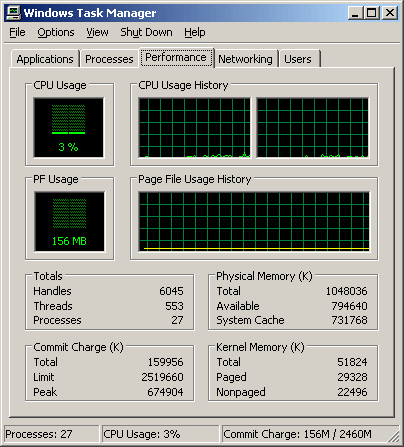AOpen Powermaster: The Motherboard of All CPU Power-Saving Solutions?
Performance: Needs Versus Capabilities
Under normal operating conditions, processor utilization varies only occasionally. We used a Pentium 4 with Hyperthreading to generate these measurements, which is why Task Manager's Performance tab shows readings for two (logical) processors.
As far as we're concerned, the big deal is not so much about the performance that fast CPUs can deliver. Heat produced when power levels just for the CPU are as high as 80 watts, if not more, are a lot for systems to handle. This sort of consumption is only justifiable when high performance has a real use, or makes a measurable boost to productivity.
Unfettered higher energy consumption, of course, is not a good thing. It's undeniable that with a processor that runs at speeds of 2 GHz or faster, typical office applications or even basic multimedia programs don't really need all that power - as you can see for yourself by viewing the Performance tab in Task Manager. Clock rates tend to stay the same all the time, as does energy consumption, no matter what users do (or don't do).
Those who can shrug off the waste involved don't care that additional cooling needed only adds to the problem. Those who call attention to the situation may be called alarmists, or told that the problem is too expensive to tackle.
Energy Management On The Desktop
Energy consumption and cooling were concerns that led processor designers to endow processors for notebooks first and foremost with functions to lower clock speeds and input voltages. Once slowed, electrical loads and performance both drop appreciably. Intel's implementation of this technology has been known for years at SpeedStep; AMD markets similar offerings as PowerNow! (for laptops) and Cool & Quiet (for desktops).
AMDs Athlon 64 Processors come equipped with Cool & Quiet, which reduces clock speeds - which vary by processor model - to levels around 800 MHz. Intel's Pentium 4 followed suit only later, at first with its expensive 600 Series with 2 MB of L2 cache. But even here, energy savings are subject to limitations because the clock rate drops only to 2.8 GHz (3.5 times the AMD rate of 800 MHz).
Get Tom's Hardware's best news and in-depth reviews, straight to your inbox.
Current page: Performance: Needs Versus Capabilities
Prev Page Powermaster: Quasi-SpeedStep For The Pentium 4 Next Page AOpen I915a-PLF With Powermaster
Patrick Schmid was the editor-in-chief for Tom's Hardware from 2005 to 2006. He wrote numerous articles on a wide range of hardware topics, including storage, CPUs, and system builds.
